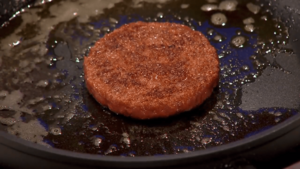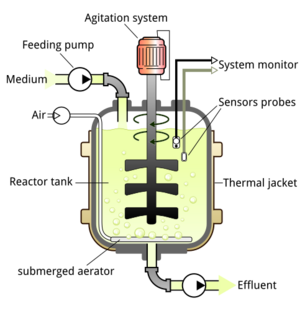Cultured meat facts for kids
Cultured meat is real meat grown from animal cells outside of an animal. It's also called "cultivated meat" or "cell-based meat." This new way of making meat uses science, similar to how doctors grow tissues for medicine.
The idea of cultured meat became popular in the early 2000s. A scientist named Jason Matheny helped start a group called New Harvest. This group was the first to focus on research for growing meat in a lab.
Cultured meat could help with many big problems. It might reduce the harm meat farming does to the environment. It could also improve how animals are treated and help make sure everyone has enough food. Plus, it might be better for human health and help fight climate change.
In 2013, a scientist named Mark Post made the first hamburger patty from cells grown in a lab. Since then, other companies have made different types of cultured meat. For example, Eat Just sold cultured chicken in a restaurant in Singapore in 2020. This was the first time cultured meat was sold to the public.
Scientists and companies are always working to make cultured meat better. This new technology has led to many discussions about ethics, health, and the environment. In 2021, companies making cultivated meat in Europe received a lot of money for their research.
Contents
The First Taste Test
The very first cultured beef burger was made by Mark Post at Maastricht University in 2013. This special burger was made from over 20,000 tiny pieces of muscle tissue. It took two years to create and cost over $300,000!
The burger was tasted live on TV in London on August 5, 2013. A chef cooked it, and two food experts, Hanni Rützler and Josh Schonwald, tried it. Hanni Rützler said it had a good "bite" and a strong taste. She noted it wasn't very juicy because it had no fat, but the texture was "perfect." She even said it tasted like real meat, not a plant-based copy.
Cool Facts About Cultured Meat
- In the 1950s, a Dutch researcher named Willem van Eelen first thought of cultured meat. He had suffered from starvation during World War II, which made him care deeply about food.
- In 2001, NASA (the space agency) started experiments with cultured meat. They wanted astronauts to be able to grow meat in space instead of carrying it from Earth. They grew goldfish and turkey cells.
- In 2008, PETA offered a $1 million prize. They would give it to the first company that could sell cultured chicken meat to people. The prize was never claimed.
- Israel is a country where cultured meat is produced in large amounts.
- The first restaurant to serve cultured meat opened in Singapore in 2021.
- As of 2023, Singapore and the USA are the only countries that allow cultured meat to be sold to the public.
How is Cultured Meat Made?
Making cultured meat involves several steps:
- Getting the Cells: First, scientists take a tiny sample of cells from a living animal. These are often stem cells, which are special cells that can grow into many different types of cells, like muscle cells.
- Feeding the Cells: The cells are then put into a special liquid. This liquid is full of nutrients, vitamins, minerals, and proteins. It's like a super-food smoothie for the cells, helping them grow and multiply.
- Growing in a Bioreactor: The cells and their food are placed inside large machines called bioreactors. These machines are similar to the big tanks used to make beer. Bioreactors create the perfect conditions for the cells to grow into muscle tissue. For example, they keep the cells warm, around 37°C (99°F), and control the air around them.
- Using a Scaffold: Sometimes, a "scaffold" is used. This is a structure that gives the cells something to grow on. It helps them form a three-dimensional shape, like a piece of meat. Scaffolds can be made from different materials, including plants.
- Harvesting the Meat: Once the meat has grown to the right size and has the desired qualities, it is "harvested." After that, it goes through normal food processing and packaging, ready to be sold.
Companies and Organizations Working on Cultured Meat
Many companies around the world are working to make cultured meat a reality. They are trying to make it taste good, be affordable, and be available to everyone.
Besides companies, there are also non-profit groups that support cultured meat. Organizations like New Harvest, the Good Food Institute, ProVeg International, and the Cellular Agriculture Society help fund research and teach people about cultured meat.
How is Cultured Meat Different from Regular Meat?
Cultured meat has some key differences from meat that comes from farmed animals:
- Cultured meat is grown in very clean places. This means there's no need to use antibiotics. In regular farming, antibiotics are often used, which can lead to problems with antibiotic resistance in humans.
- Raising animals for food can cause a lot of pollution and carbon emissions. Cultured meat is expected to have a much smaller impact on the environment.
- It needs less land, water, and energy to produce compared to traditional meat. This makes it more environmentally friendly.
- No animals need to be raised or killed to make cultured meat. This makes it a more ethical choice for many people.
- Since cultured meat is new, people are still learning about its safety, taste, and how healthy it is compared to traditional meat.
Cultured Meat and Religions
Different religions have different views on cultured meat:
- For Jewish people, there are discussions about whether cultured meat is kosher (allowed by Jewish law). Some religious leaders say it is kosher if the original cells came from an animal that was slaughtered according to Jewish law. Others think it might be kosher even if the cells came from a live animal, or even from animals not usually considered kosher, like pigs.
- For Muslim people, the rules are similar. If the cells don't come from animals like pigs or dogs (which are considered haram or forbidden), then the cultured meat might be seen as similar to plant-based foods like yogurt.
- Hinduism usually avoids eating beef. A Hindu leader said he would not want cultured beef to be sold.
- Catholicism has rules about not eating meat on certain days, like during Lent. The church has not yet said if cultured meat would be included in these rules or if it would be allowed like vegetables or fish.
Images for kids
-
Pasta dish with strips of Good Meat's cultivated chicken meat, served to the public in a restaurant in Singapore.
See also
 In Spanish: Carne cultivada para niños
In Spanish: Carne cultivada para niños
- BioTech Foods
- Cellular agriculture society
- List of meat substitutes
- Meat analogue
- Timeline of cellular agriculture
- Tissue culture











